Margaret Fuller 1810-1850-From Transcendentalist Philosopher to Investigative Journalist
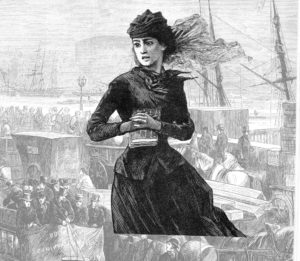
**Last week, as I gazed out into the ocean at a sandbar just offshore from Point O’ Woods, Fire Island, I found it hard to believe that on July 19, 1850 Margaret Fuller, brilliant member of the Transcendentalist circle, feminist, and journalist, drowned there as her sailing ship lay aground in a raging storm.
I was standing on that beach because my brother, Alexander D. Platt, had organized Margaret Fuller Day in Point O’Woods to honor the memory of this extraordinary woman. The guest of honor was Megan Marshall who won the Pulitzer prize for her book Margaret Fuller A New American Life. In addition we heard from two speakers on “Margaret Fuller’s 1844 Journal and its Unfolding Stories,” Finally we had a lively presentation on the shipwreck itself and the shortcomings of rescue techniques in 1850.
In these presentations, Fuller emerged as a pioneering feminist, philosopher, and journalist at a time in the 1830s and 1840s when women had little freedom to speak, write, or even think for themselves.Fuller planted the seeds for radical women in Boston that led to the feminist movement in the United States which began in earnest in 1848 at Seneca Falls.
Why did she drown off the coast of Point O’Woods?? Fuller had sailed from Italy where she had been reporting on the Italian revolution (note how extraordinary that fact alone is), had fallen in love with an impoverished radical count, and had a baby out of wedlock. Fuller was a radical women who ignored social mores, believed in the equality of the sexes, and pioneered fearlessly in everything she did.
But the sailing ships of the 19th century were fragile in the face of wild storms and to be shipwrecked was usually fatal.
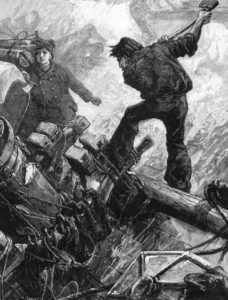
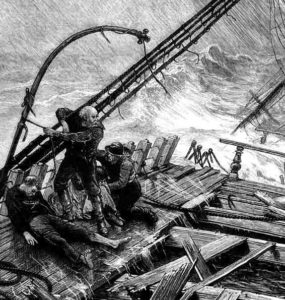
She, her lover (possibly her husband) and her baby all drowned in the shipwreck caused by the incompetence of a substitute captain ( the captain had died of smallpox shortly after the departure from Italy.) The ship was a sailing ship, (steamboats cost more and she was impoverished), it carried a marble statue by Hiram Powers of John Calhoun commissioned by the city of New Orleans and other marble. The marble cargo meant that the ship could not get off the sandbar where it had run aground, and it was gradually torn to pieces by a storm.
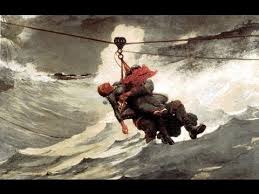

A few crew members swam ashore, the captain’s wife came ashore on a specially rigged line (as in Homer’s Life Line, a more organized version of that process) , but Fuller refused to leave the ship, her baby and her lover, she did not know how to swim. They all drowned. Meanwhile on shore scavengers ignored the stranded people and collected the ship’s cargo. At that time no manned lifeboats existed on the shore. (The image above is imaginary and apocryphal, reducing Fuller to a passive traditional woman.)
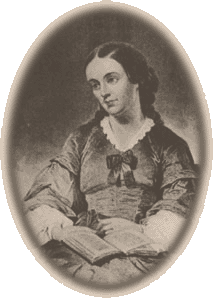
But the main story is Margaret Fuller herself and the context in which she developed. She was blunt, outspoken and brilliant at a time when few women spoke at all. Her brilliance was the direct result of her education by her father, who taught her from a precocious age, and her own self education. She went from studying Latin at the age of six to exploring conditions for women in prisons as a journalist in the 1840s.
Margaret Fuller stood out among the free thinkers who congregated in Concord Massachusetts in the late 1830s and 1840s around Ralph Waldo Emerson. She was a dazzling presence among the men of the Transcendentalist circle, all of whom, had women to support them.
Thinking it would give us insights into that Transcendentalist circle (wonderfully described in Susan Cheever’s book American Bloomsbury) my husband and I went to an exhibition at the Pierpont Morgan Library “This Ever New Self, Thoreau and His Journals.” The exhibition honors the 200th anniversary of Thoreau’s birth.
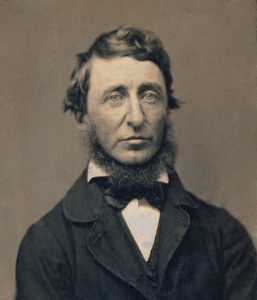
What we learned is that Thoreau is the polar opposite of Margaret Fuller, suggesting the breadth of the transcendentalist movement. He was an introvert who spent a lot of time alone, looking at nature, recording its changes, supported financially most of the time, by the money of other people, as well as in his personal needs by his mother. Fuller was an extrovert and a single woman. She had to support herself, and frequently she was supporting her family as well.
Still, before returning to Fuller, I want to mention that as a writer, I loved the Thoreau exhibition, even though he had little to do with Margaret Fuller.
The exhibition outlined his interests and his politics. Coming from an elite Harvard education, as did Emerson (but not Nathaniel Hawthorn or Bronson Alcott), Thoreau took the transcendentalist resistance to conventions the farthest, he shed all social expectations, almost all possessions, and spent much of his time observing and recording the details of the natural world. But he shared his amazing knowledge as a teacher ( Louisa May Alcott as a young girl was his pupil and had a crush on him), and, in his well known writings.
The central idea of the Transcendentalists was that nature is the source of true spirituality, more than any God constructed by organized religion. But humans fail to recognize their mystical connection to nature in their distraction with material possessions. Emerson first developed this in his essay on Nature in 1836. But Thoreau went much further in his immersion in the minutiae of nature itself. As a result of his detailed observations of birds, flowers, trees, insects and so much else, his journals are a useful reference today as climate change eliminates so many species, and the dates of seasonal blooming changes radically. (See Walden Warming, Climate Change comes to Thoreau’s woods, by Richard B Primack)
At the same time, he participated in the world. The exhibition highlighted Thoreau’s fervent defense of John Brown (an odd campaign for the peaceful men of Concord, which Susan Cheever finds horrifying and based on their naivete) , his disdain for a government that justified slavery, his assistance on the escape of slaves to Canada.
Another section addressed his knowledge of the indigenous people of Concord, the Wampanoag. He learned their language, he discovered their artifacts, he respected their beliefs. Indeed his perspective on nature is much closer to indigenous beliefs in the continuity between ourselves and the natural world, than that of the Enlightenment in which we are the conquerors of the natural world.
As a writer, I was most excited by his process: he walked about with small scraps of paper on which he made notes, he then transferred these to a journal, from that journal he excerpted for lectures, and edited sections for books. (I kept thinking of my own utterly disorganized journals that hopefully no one should or will ever read).
Although Fuller of course knew Thoreau in Concord as she spent more and more time there with Emerson, as the editor of the
literary/philosophical magazine the Dial in 1840-42, her main focus was philosophy, words, ideas, thoughts, literature, writing and above all conversation and social connections in the most positive sense of substantive friendships. She and Emerson had an intense relationship, although probably not a sexual one. ( as was also the case with Nathaniel Hawthorne).
She invited many women to contribute to the Dial, and wrote fervently on the equality of men and women ( see below).
As a critic, I particularly appreciated her writing on criticism, in this passage showing both her acerbic wit and her sharp insights: “Essays, entitled critical, are epistles addressed to the public, through which the mind of the recluse relieves itself of its impressions. . . . Or they are regular articles got up to order by the literary hack writer, for the literary mart, and the only law is to make them plausible… Critics are poets cut down, says some one–by way of jeer; but, in truth, they are men with the poetical temperament to apprehend, with the philosophical tendency to investigate”
In other words to be a good critic you need to be a philosopher, poet and observer. I like that idea.
Most of the Transcendental group were entirely broke, most of the time. Ralph Waldo Emerson, who had inherited money from a young wife who died young, supported almost everybody. Fuller edited the Dial without pay – she supported herself with occasional teaching and “conversations,” held at a bookstore run by Eliza Peabody, another feminist and first female publisher in Boston. These all female conversations among the intelligentsia of Boston became a strong foundation of the suffragette movement.
Ralph Waldo Emerson suggested that Thoreau submit a piece to the Dial. Fuller rejected it with caustic words “the thoughts seem to me so out of their natural order, that I could not read it through without pain. I never once felt myself in a stream of thought, but seem to hear the grating of tools on the mosaic. “
Fuller had to make a living, so she boldly moved on to New York City to be the first female journalist for a major newspaper, invited by Horace Greeley, editor of the New York Tribune. She pioneered front page stories on orphan asylums and conditions in women’s prisons. She convinced the newspaper to send her to Europe to cover the 1848 uprisings there and that is how she came to be on the sailing ship Elizabeth, after reporting on the Italian revolution. Thoreau himself went to look for her lost manuscript about the Italian revolution, but he came back without it.
But in the end, going to the beach at Point O Woods, a stunning expanse of uninterrupted ocean ( very different from our rocky cliffs and steep forests here on the west coast), all I could think of was how close to shore the sailing ship went aground, only 50 meters and how incredible that Margaret Fuller and her family drowned there, with scavengers standing on the beach.
In Point O Woods, a gazebo was erected in honor of Fuller, (the dynamic women’s committee wanted a library, but the men of Point O Woods only approved a gazebo. It washed out to sea a few years later.
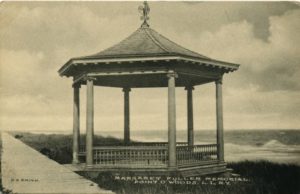
But there are other memorials to Margaret Fuller in Boston and Cambridge, as detailed on this blog.
Her greatest monument though is her own writing. Women of the Nineteenth Century, expanded from her 1843 essay in the Dial advocating equality of the sexes “The Great Lawsuit: Man vs Men, Woman vs Women.” She was way ahead of her time in suggesting that “there is no wholly masculine male and no purely feminine woman.” Her letters reveal her deep friendships in My Heart is a Large Kingdom, her book Summer on the Lakes in 1843 on her trip on the great lakes (going on steamers from one place to another) marks a particular time and again her perceptions are far ahead of her contemporaries.
She describes staying on Mackinaw Island where Chippewa and Ottowa tribes “are here to receive their annual payments from the American government. As their habits make travelling easy and inexpensive, neither being obliged to wait for steamboats or write to see whether hotels are full, they come hither by thousands and those thousands in families, secure of accommodation on the beach and food from the lake. ” There follows a rant on the iniquities of so called Christian traders who offer the Indians rum in order to take advantage of them.
My local public library even had Life Without and Life Within, Reviews, Narratives, Essays and Poems, published by her brother in 1895. In it I found her review of Frederick Douglass’s newly published autobiography, Narrative of the Life of Frederick Douglass published by the Anti Slavery Office in Boston, 1845. “It is an excellent piece of writing and on that score to be prized as a specimen of the powers of the black race, which prejudice persists in disputing. We prize highly all evidence of this kind, and it is becoming more abundant.”
Fuller, like all the Transcendetalists, immersed herself in German philosophy, and classical literature, but she moved on to address the world as she saw it in the 1840s, a world of inequalities, of slavery, of exploitation. She courageously opposed in her life and in her writings, the oppressions of traditional social and religious practices and the repression of women.
I wish she were here today with her incisive writing. We need her fearless voice to address the ignorance and hypocrisy of our current leaders as they celebrate escalating oppression in the guise of “freedom.”
** I have been away from this blog since February because I had knee surgery. I am still not going to large exhibitions, but here is my modest return.
This entry was posted on June 23, 2017 and is filed under Feminism, Uncategorized.








